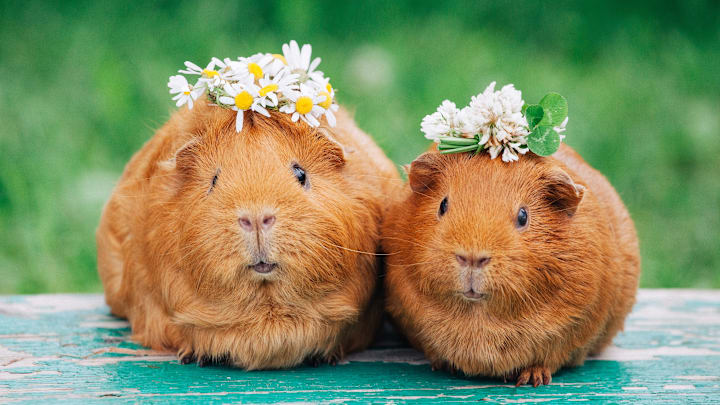Thanks to their small size and friendly nature, guinea pigs are pretty popular pets. If you’re thinking of getting a guinea pig of your own—or you just want to finally figure out how they're different from hamsters—here are 11 facts about the fluffy little rodents.
1. We don't know why they're called guinea pigs.
Their name continues to stump people. Guinea pigs are certainly not related to pigs—they're part of the Caviidae family, while pigs are part of the Suidae family—though they do squeak like piglets, which some think may have inspired the moniker.
They also didn't originate in New Guinea, and instead were domesticated in the Andes of Peru. They were traded throughout South America, and then beyond after European colonizers arrived.
2. There are 13 species of guinea pigs.
The American Cavy Breeders Association recognizes 13 types of guinea pigs, and each species is likely to have a slightly different temperament. Though guinea pigs are generally known for being lovable, cuddly creatures, most people find that the Teddy Guinea Pig is the friendliest of them all.
3. Guinea pigs are herbivores.

If you’re wondering what guinea pigs eat, the answer is plants. The fluffy critters are herbivores, which means they nosh on fruits and vegetables. Among the guinea pig’s favorite treats are broccoli and carrots.
It’s also important to feed them a combination of hay or grass and guinea pig pellets. Experts recommended that about 5 percent of their diet should be in pellet form; 15 percent should be fruits and vegetables; and the rest of their nourishment should come from hay and grass.
4. A guinea pig’s teeth never stop growing.
There’s a reason these animals should munch on a lot of hay: Most guinea pigs have 20 teeth that never stop growing. These “open-rooted teeth” need regular care in order to stay healthy. If a guinea pig's teeth get too long, they'll have a hard time eating their food. Gnawing on hay throughout the day helps file their chompers and keep them from over-growing.
5. Guinea pigs can bite.
It’s relatively uncommon for a guinea pig to sink their teeth into you, but they're certainly able to do so. When they feel particularly afraid or stressed, guinea pigs may resort to biting as a way to signal that something is wrong.
Generally, guinea pigs are quite sweet, and they can easily be handled without incident. Some may gently nibble on their humans out of curiosity; this habit is harmless, and usually doesn’t hurt.
6. Guinea pigs are active during the day.

While hamsters and rats are nocturnal, guinea pigs are actually diurnal creatures. This means they’re usually awake during the day and sleep at night. Guinea pigs may make better pets than rats and hamsters for this reason, since you're more likely to see them out and about when you're also awake.
7. Guinea pigs are not hamsters.
The guinea pig and the hamster are in the same family of animals. But they're entirely different species, and have a lot of differences. For one, guinea pigs usually grow to be about double the size of a standard hamster. Because of their size, they usually require a bigger enclosure.
Guinea pigs also tend to live longer than hamsters, and they're also more social, so you should make sure to have at least two. In Sweden, it's actually illegal to own just one guinea pig.
And unlike hamsters, they shouldn’t use exercise wheels or balls because of the shape of their spines—their backs can’t bend the way they would need to to run on a curved surface.
8. Guinea pigs are usually active for about 20 hours per day.
Though a guinea pig doesn’t exercise in the same way that a hamster does, that doesn’t mean they’re the couch potatoes of the rodent world. Guinea pigs are usually awake and active for about 20 hours per day. This makes the guinea pig a great pet for those who want a lot of play time. Guinea pigs love tunnels; large piles of hay and pipes can help keep them active and healthy.
9. Most guinea pigs have 14 toes.

Most guinea pigs have four toes on each of their front paws, and three on each back paw. But these little creatures can be polydactyl, which means they could develop more than 14 toes.
10. Guinea pigs typically live anywhere between five to 10 years.
Ordinarily, guinea pigs have a lifespan of about five or six years. Sometimes, though, a particularly healthy guinea pig may live to be somewhere between eight and 10 years old.
According to the Guinness Book of World Records, the oldest recorded guinea pig that ever lived made it to 14 years and 10.5 months old. He was named Snowball, and he lived in the UK until he died on Valentine’s Day in 1979.
11. Guinea pigs can swim.
Like many animals, guinea pigs can swim; it’s a survival skill they evolved to help them escape predators or get out of any water they may have fallen into. In fact, some guinea pigs have been observed swimming for up to five hours at a time. But they don’t usually enjoy it, so it’s probably best to keep them out of the water.
